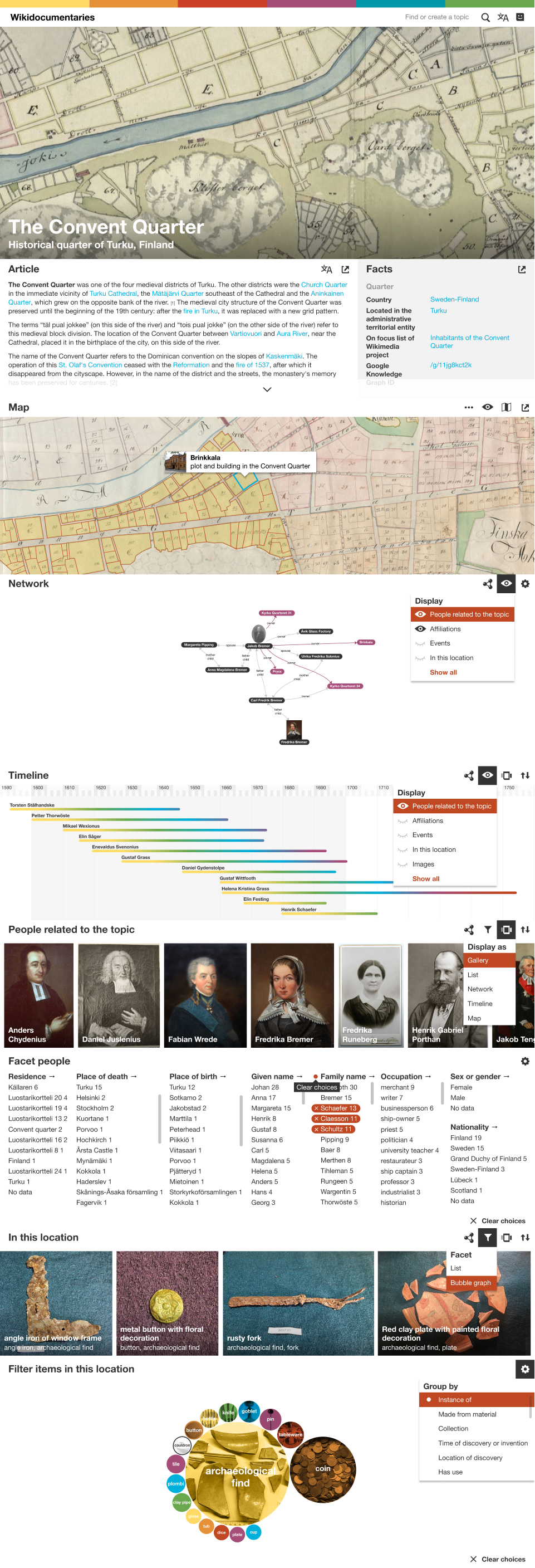Convent Quarter
This is a collaboration with Aboa Vetus & Ars Nova. The goal is to display the interconnections of the museum collections with the help of Wikidocumentaries. New developments will be made available for all users.
The museum is located in a building that replaced a wealthy and central part of medieval Turku in Finland, after a fire devastated the part of the city. Part of the museum is focused on archaeology of the site, while the other part focuses on contemporary art.
Contents
Objectives
- Display information about archaeological finds, and the history of the houses and plots where they were found, and the people who lived there.
- Find ways to overcome the scope limitations of the Wikimedia projects. Notability becomes an issue with historical biographies. The granularity of archaeological finds challenges the scope of Wikidata.
- Contribute to open knowledge as much as possible.
- Serve museum visitors onsite and online.
Data
Available content and platforms
- Content that can be published through Wikimedia projects
- Wikidata items about notable historical personalities, geographical sites
- Wikipedia articles of the most notable personalities
- Images on Wikimedia Commons
- Source literature
- Images released by the museum in Finna (TBD)
The need for extended storage
- Archaeological finds: data, articles, and images about them
- Biographical information, especially articles
- Historical geodata: houses, plots, street etc.
- Historical documents?
- Linking between them
Data management scenarios
- Use Wikimedia projects as much as possible
- Develop a complementary or alternative data storage or outlet that can be controlled oneself: Google Sheets or Wikibase. The data solution should be scalable and/or replicable.
Wikibase
The Wikibase alternative could be made for this project or as a shared one (for example Wikidocumentaries Wikibase or a local history Wikibase). Developing the federated ecosystem of Wikibases is a thing we want to contribute to with Wikidocumentaries.
Desired developments for display components
General
- Grouping and faceting of the objects based on most used properties. In this case for example
- Type of object (instance of)
- Creation date
- Era
- Place of discovery
- Use
Network visualization
- https://w.wiki/BsF
- Different visualizations, such as family relations, professional relations etc. This can be realized as separate displays in the exhibition space, or by including a network visualization in all components, or through faceting as part of the Wikidocumentaries site.
- Custom styles and features for use in the exhibition space
- Linking to Wikidocumentaries pages instead of Wikidata pages.
Archaeological finds (Component: In this location)
- Visually more engaging, for example grouping
- Display of an individual objects with more metadata
- Possibly a bespoke component to display a specific external dataset
Map
- Map shapes for more objects
- Display of historical data
- Display georeferenced old maps
Article
- Make sure articles can be written on all the items, and displayed on Wikidocumentaries
- Either write in a dedicated repository (Wikibase) or enable displaying external articles
People
- Display people related to a house in all possible ways: family tree, network, timeline
- Develop a view that brings together the different interrelations: houses and households spatially, family relations, business relations and interactions, the passing of time
Similar
- Enhance the relevance of the related entries. The selection criteria can be enhanced to better take into account archaeological finds.
Images
- Enhance the relevance of the related images. This requires an in-depth development project to images, and there are many ways in which it can be made better.
Historical geodata
OpenHistoricalMap
It would be relatively easy to read shapes from OpenHistoricalMap to Wikidocumentaries similarly to how they are read from OSM now.
- OHM entities can be linked to Wikidata
- Based on the Wikidata ID, they can be linked to Wikidocumentaries
- Shapes can be managed with the iD editor in OpenHistoricalMap
IIIF
In parallel, it would be a great idea to display IIIF data. This will open up several new opportunities that can be explored further.
| About | Technology | Design | Content modules | Tool pages | Projects |
| Status
Wikidocumentaries Slack |
Setting up dev environment |
Components |
Active modules Module ideas |
Visual editor | Central Park Archives |
